Here in Arkansas, the Natural State, we love ducks! Whether you’re a weekend duck hunter or a duck watching enthusiast, Arkansas provides no shortage of ducks. Most people are familiar with mallard ducks but few, if any, other duck breeds. Ducks are an important part of the ecosystem in the state, and they can do everything from encouraging the spread of some plant species and improving biodiversity to serving as a food source to large predators in wetlands.
Understanding some of the ducks you might encounter in Arkansas can help you do your part for the environment. You should know when to alert authorities of invasive or sickly ducks and better understand the role different ducks may play in the environment. Here are the duck breeds you’re most likely to encounter in the state of Arkansas.
 What Types of Ducks Live in Arkansas?
What Types of Ducks Live in Arkansas?
- Dabbling Ducks: You’ve definitely seen dabbling ducks and likely didn’t realize that’s what they were. Dabbling ducks are a group of ducks that feed by putting their head underwater to graze on lush aquatic plants. While feeding, you’ll see dabbling ducks sticking their tails upward in the air while their head disappears below the surface.
- Diving Ducks: These ducks are far less commonly spotted than their dabbling cousins. Diving ducks dive below the water’s surface for food, fully submerging themselves in the process. They can swim very effectively underwater and often have smaller, more pointed wings than dabbling ducks. This wing shape means they typically cannot take flight directly from the water’s surface and instead can be seen running on the surface to gain enough momentum to take flight.
The 20 Most Common Breeds of Duck in Arkansas
1. Mallard
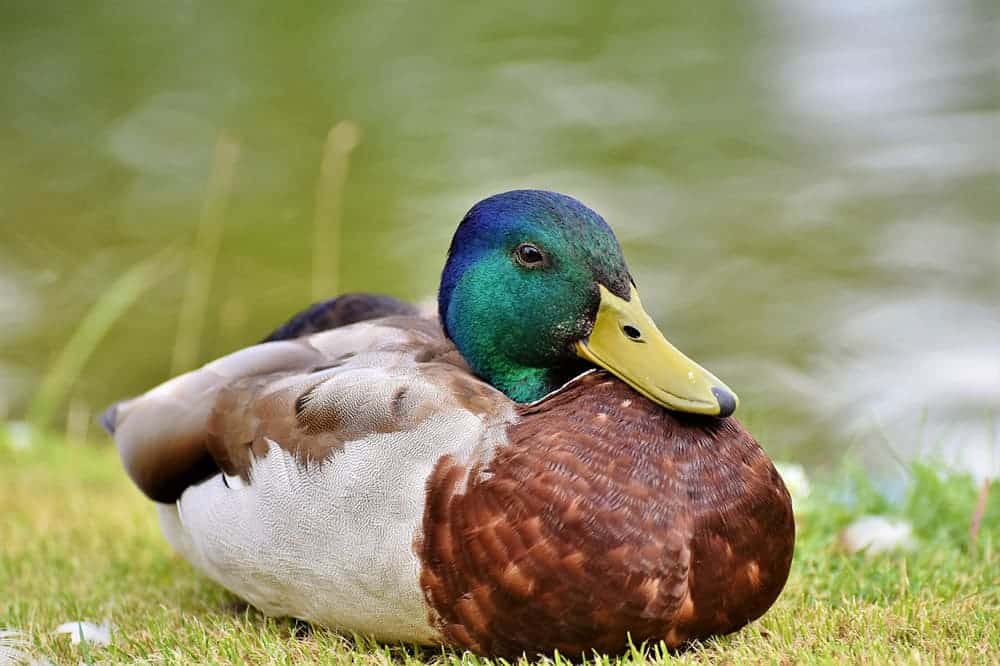
Easily the most common duck in the state, mallards are dabbling ducks that are extremely popular for hunting. Males are distinct with shiny green feathers on the head and a white ring around the neck. Females are drabber, often appearing in mottled shades of brown, tan, and white. Males and females both sport attractive purple-blue feathers on a small portion of the wing that is easiest to spot when the bird is standing or flying. Mallards can be found throughout the state of Arkansas, regardless of the season. Male mallards do not quack, but females do.
2. Ring-Necked Duck

The ring-necked duck is a diving duck with a pointed head and a gray bill with a black tip and white band across the top. Females tend to be dark brown or chestnut with a light gray throat and face, with white or light gray around and behind the eyes. Males have glossy plumage and are primarily black, with off-white or light gray down the sides of the body. Males’ eyes are orange or yellow, while females’ eyes are dark brown or black. Although they have a ring around the neck, giving the ring-necked duck its name, the ring is dark brown and blends in with the rest of the neck, making it difficult to spot from a distance.
These ducks spend the winter in Arkansas. Even though they are diving ducks, they prefer shallow water. Some even spend their time in swampy wetlands. They are social birds that gather in large flocks of hundreds to thousands of birds in the winter. In the breeding season, though, you will rarely see more than a couple of ring-necked ducks together.
3. American Wigeon
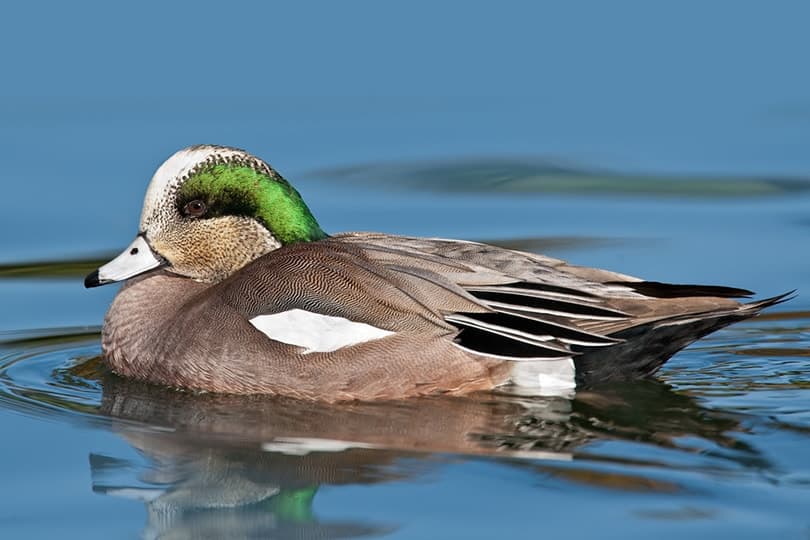
These dabbling ducks are compact in build and have blue-gray bills with black tips, regardless of sex. Females are brown with a grayish head, while males are primarily brown but sport a white crown and green banding behind the eyes. These ducks are shy, often staying away from areas that humans frequent. They overwinter in Arkansas and are not usually seen but can be identified by the whew-whew-whew call of the males and the grunting quack of the females.
4. Lesser Scaup
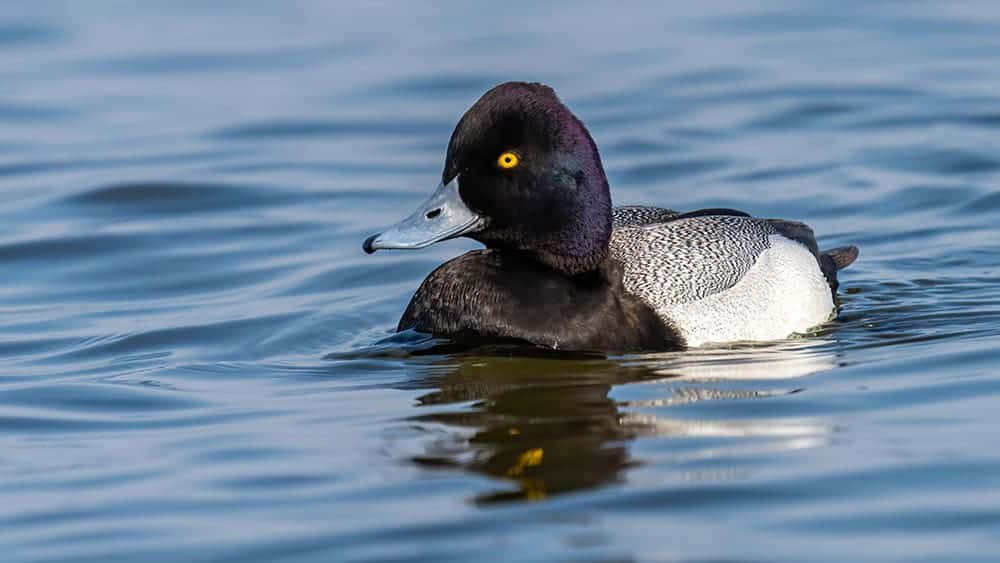
Although the lesser scaup is the most populous diving duck in North America, it is unusual to spot them in Arkansas. Females have a reddish-brown body with a dark brown head and a distinct white patch near the base of the bill. Males have glossy feathers with a black head with yellow eyes, dark-colored tail and breast, and speckled gray along the back, sides, and wings.
These ducks may overwinter in Arkansas, where they can be found on large bodies of water. They tend to spend the winter in large flocks of hundreds or thousands of birds. Males tend to be silent, while females are slightly more vocal with a vocabulary of gruff grunts and barks.
5. Greater Scaup
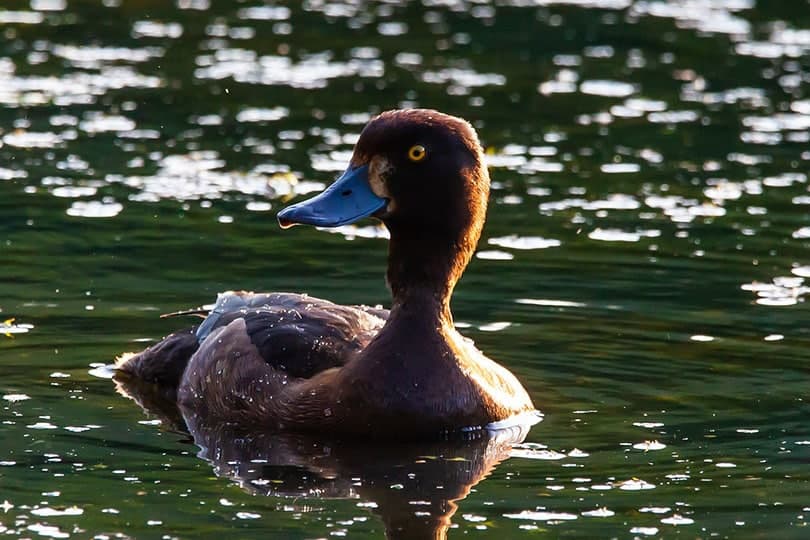
Similar in appearance to the lesser scaup, the greater scaup can be differentiated by its rounded head, while the lesser scaup has a more pointed head. Otherwise, the males and females of both species are nearly identical.
These birds may overwinter in Arkansas but are not common. Interestingly, they tend to breed in the Arctic, with some breeding as far north as the North Pole. They are social birds that gather in large flocks of hundreds or thousands.
6. Bufflehead
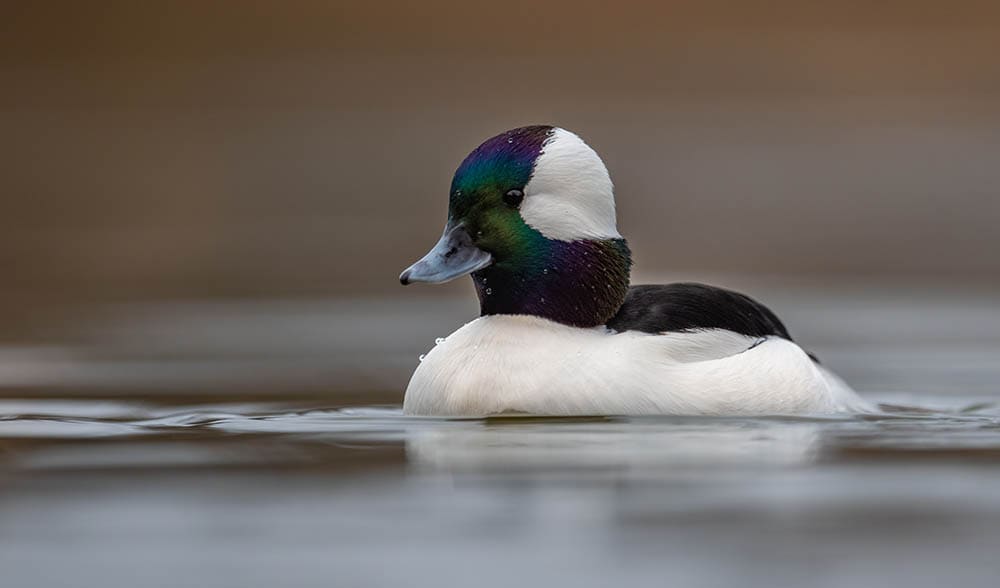
These cute diving ducks are easy to identify but may be difficult to spot due to their habit of spending a lot of time foraging and eating underwater. They are small but have large heads by comparison. The males are primarily white but feature iridescent feathers on the face and a black or dark brown back. Females are brown or tan with a darker head and a white patch on the cheek.
Buffleheads only overwinter in Arkansas, so you’re unlikely to come across a nest. When they nest, they lay their eggs in a hollow or nesting box. They tend to be one of the quieter duck species, although the males do sometimes make a squeaking, whistling sound.
7. Canvasback

This large diving duck is pretty unmistakable, with its wedge-shaped head and steep, sloping forehead. Females tend to be dull brown or tan with darker brown on the breast and head. Males also have dull brown or tan bodies, but tend to have cinnamon or reddish-brown heads. Males have red eyes, while females have black eyes.
Canvasbacks are unusual ducks in that they rarely leave the water. They eat, sleep, and nest on the water. They build their nests in masses of floating aquatic plants. They typically overwinter in Arkansas and rarely make any noise. They tend to be uncommon ducks in Arkansas.
8. Common Goldeneye
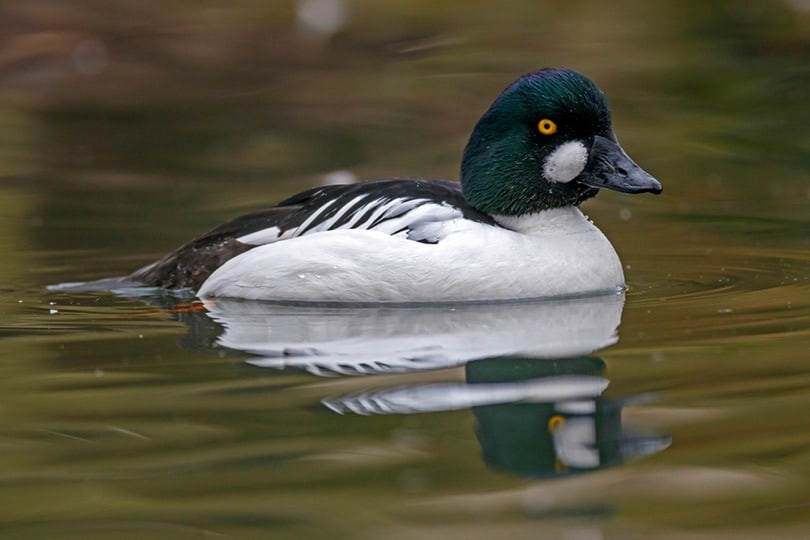
The common goldeneye is a diving duck that will stay underwater for around a minute while searching for food. Males have a dark green to almost black head with white cheek patches and bright yellow eyes. They have a white or off-white body with black along the back and tail. Females have a tawny brown head with light yellow eyes, a white neck collar, and a grayish or tan body.
They are cavity nesters, which means they make their nests in hollows and nesting boxes. These birds thrive in areas where hollow trees are not cut down. They overwinter in Arkansas, and while flying, their wings make a distinctive whistling sound. Otherwise, they are quiet ducks that don’t make much noise.
9. Redhead
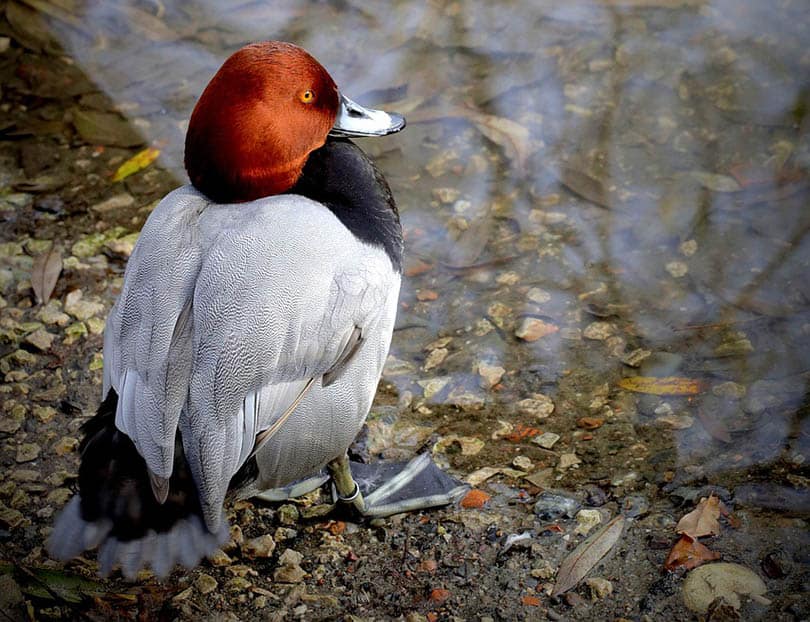
This diving duck has a steep forehead, rounded skull, and a grayish bill with a black tip. Females are tan or brown with a lighter-colored face and black eyes. Males have a cinnamon-colored head with bright yellow eyes, black breast, and gray body.
These ducks overwinter in Arkansas and are highly social, often gathering in large flocks of hundreds or thousands of birds. Their overly social nature makes them particularly susceptible to falling for hunting decoys, making this a popular duck with hunters. These unusual ducks practice what is called “brood parasitism,” which means that the females will lay their eggs in the nests of other duck species, which then hatch and raise the young for the redhead. However, some female redheads build their own nests and hatch and raise their own young.
10. Gadwall

While female gadwalls look similar to female mallards with a mottled brown appearance, males have small feathers with a delicate design that gives them a scaley appearance. Males are a combination of gray, black, white, and brown. Males and females have a patch of white feathers on the wings that is only visible while the bird is in flight.
They are dabbling ducks that can frequently be found on bodies of water with large amounts of plants. They typically overwinter in Arkansas, but if you manage to spot a gadwall in the warmer months, keep an eye out for its stealing habit. These ducks are known to wait for diving ducks to surface and steal the food the diving duck retrieved. The easiest way to identify a gadwall is to listen for the distinctive burping call of the males.
11. Northern Pintail
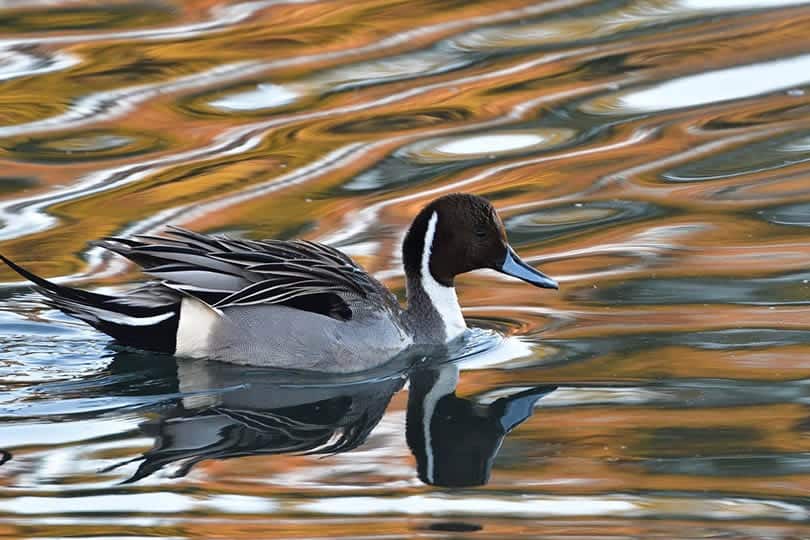
These dabbling ducks have an elegant appearance, with slender bodies and elongated necks and tails. Females are relatively drab with feathers that are combinations of brown, tan, and white. Males have a reddish-brown head, white throat and breast, and blue-gray body. Both sexes have long, pointed tails, with males having more exaggerated tails than females.
These shy birds can often be found in places away from people, like wildlife refuges, but they prefer shallow water. They are quite comfortable on land as well, so it’s not uncommon to spot northern pintails in fields picking up leftover grains from crops like corn, barley, and rice. Since they tend to overwinter in the state, northern pintails may be seen cleaning up fields between harvest and planting.
If you startle these birds or see them during migration, be prepared to see rapid movements. These ducks have been known to fly up to 48 miles per hour during migration, with the longest non-stop northern pintail flight on the record being 1,800 miles. They only migrate at night, and males have a whistling call that has been compared to that of a train whistle.
12. Northern Shoveler
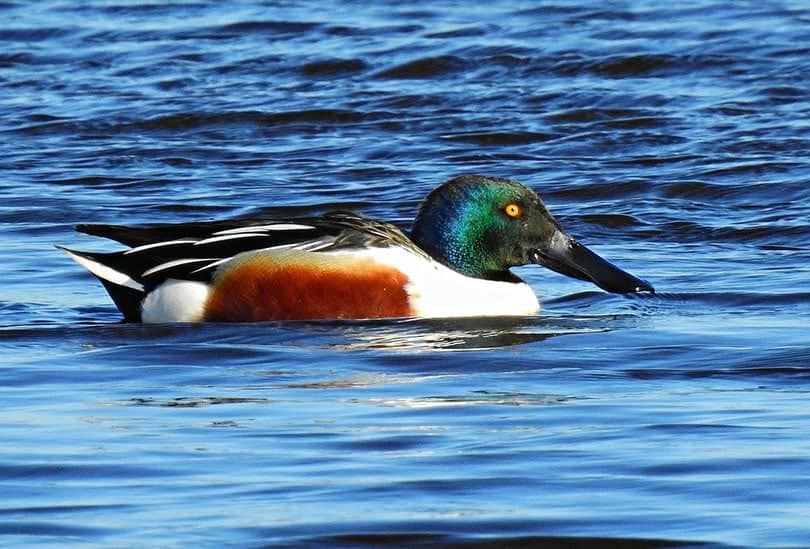
Northern shovelers are dabbling ducks with a very noticeable, spoon-shaped bill they use to shovel food into their mouth. Males have a white breast, black back, reddish-brown body, green head, and yellow eyes, while females are brown and may have a bluish patch of feathers near the shoulders. Without getting a good look at the bill, you may confuse a male northern shoveler with a male mallard.
These ducks use their bills to filter through mud, sand, and silt to find small animals, like mollusks, insects, and crustaceans. They have specialized ridges on the edges of the bill that aid in filtering for food. Males make a deep took-took call, while females have a more high-pitched, nasally quack.
13. Black-Bellied Whistling Duck

The black-bellied whistling duck is interesting because the males and females look almost identical. They have a light grayish head with a cinnamon to chestnut stripe that runs from the top of the head down the back of the neck, where it meets the same color across most of the body. The abdomen is black, and the wings have a white patch that is visible in flight and at rest. These ducks have unusually long legs with reddish or pinkish bills and legs.
These ducks breed in the southernmost part of Arkansas, as well as along the Mississippi River. They nest in trees, often taking over abandoned woodpecker hollows. They spend most of their time out of the water, and they are excellent at walking and perching, thanks to their long legs. They may be spotted in fields cleaning up left behind corn, wheat, and rice. They make a whistling call that starts off long and loud and then breaks down into a series of shorter chirping whistles.
The black-bellied whistling duck is not a dabbling or diving duck. It belongs to a small genus that only contains eight living species in the world. They are the only ducks in the Dendrocygnidae family.
14. Blue-Winged Teal

Male and female blue-winged teals have a beautiful blue shoulder patch that is most visible while the birds are in flight. A bright green patch of feathers sits below the blue shoulder patch. Females have a mottled brown appearance with a black eye-line and crown, while males have a bluish-black head, a white band in front of the eyes, black wings, and an intricately patterned body that is brown with black markings.
These dabbling ducks are not common ducks in Arkansas, and they typically only show up while migrating. However, this is the second most populous duck breed in North America, so they are far from a rarity.
15. Green-Winged Teal
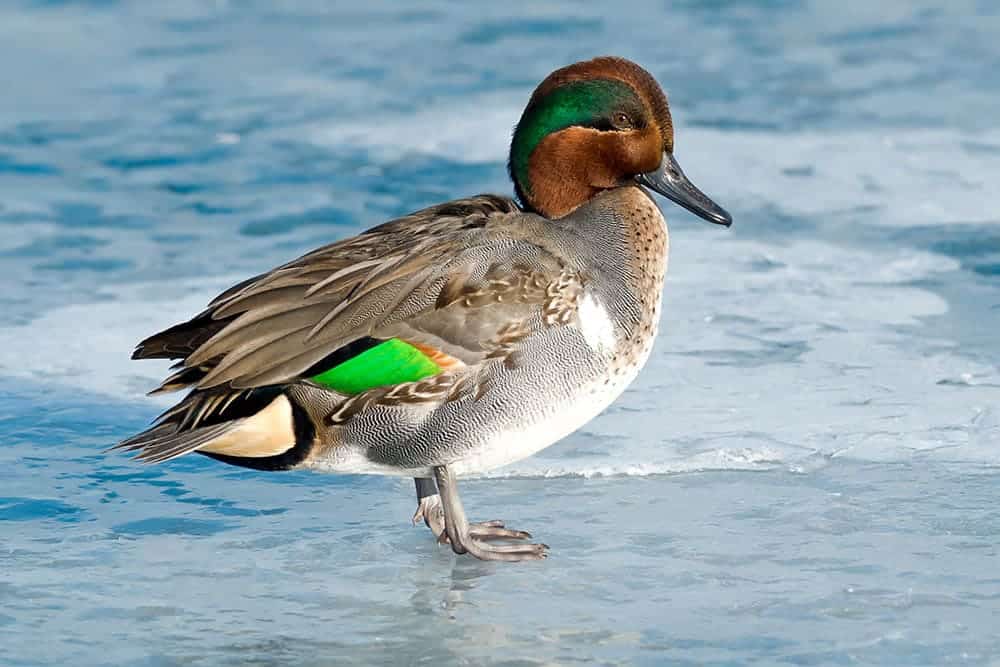
Both male and female green-winged teals have a bright green shoulder patch that is always visible in flight and is usually visible at rest as well. Females are mottled brown and tan with a dark brown eye line, while males have a chestnut head with dark green ear line, gray and brown barred bodies, and vertical white stripes on both sides of the body.
They are the smallest dabbling ducks in the state and tend to only overwinter in Arkansas. It’s common for these ducks to befriend other duck species, often integrating into their flocks. This makes them easy to identify since the smallest ducks in a flock are likely to be green-winged teals. They are the second most popular hunting duck in the US, behind the mallard.
16. Ruddy Duck
The ruddy duck is a diving duck with a scoop-shaped bill. Females are a soft brown color with a dark brown cap on top of the head and a black bill. Males have a chestnut body with a stiff, black tail, a black cap that transitions down the back of the neck, a dark brown breast, white cheeks, and a bill that is soft blue in color.
These ducks overwinter in Arkansas, but if you have the opportunity to see the males attempting to woo females, you won’t be disappointed. Males will hit their bill against their neck in such a way that air is pushed through the feathers, creating bubbles in the water. They then give a belch-like quack. They will repeat this until they find a female to breed with.
17. Mottled Duck
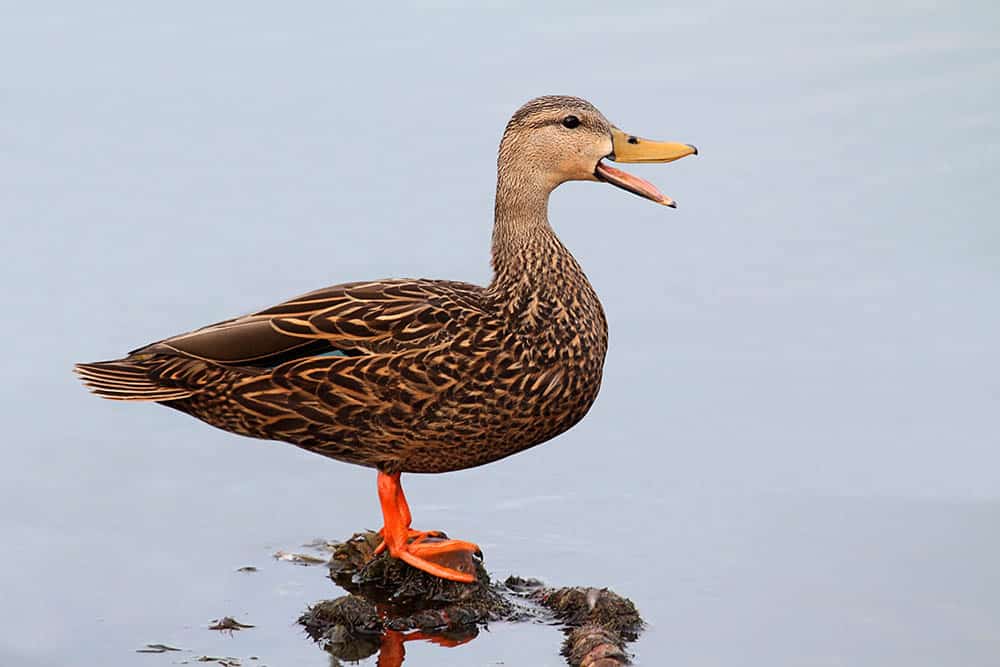
The mottled duck is a difficult one to spot because both males and females are mottled brown and tan, much like the females of many other species. To identify them, look for the black-tipped, yellow bill of the males and the orange-tipped, black bill of the females. They are closely related to mallards and often crossbreed with them, leading to hybridization. Like mallards, mottled ducks are dabbling ducks.
In the southeast corner of Arkansas, mottled ducks may be found year-round. They may be found at random in other southern parts of the state but are rarely spotted further north than central Arkansas.
18. Wood Duck
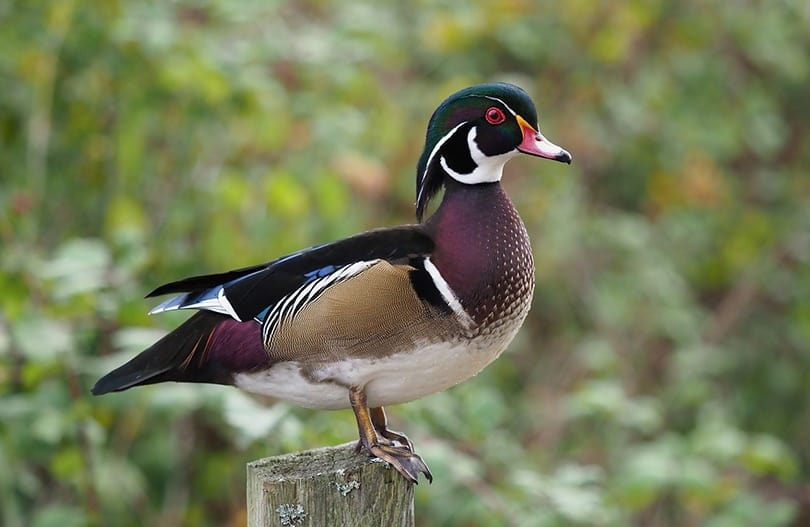
These dabbling ducks are one of the more unique looking ducks due to their plumage and the fact that females and males both exhibit bright feathers. Females have a slight crest on their gray heads with brown, tan, and white mottling throughout the body. They have a white eye patch that is teardrop-shaped and an eye-catching blue wing patch. Males have a distinct, slicked back crest on the head, which is green and white. They have a chestnut breast, gray or tan body, and darker feathers on the wings and back with a blue wing patch and a chestnut to maroon patch near the tail.
Wood ducks can be found in Arkansas year-round and nest in tree hollows. Their young can be seen jumping from up to 50 feet up when they leave the nest. Unlike most ducks, wood ducks can perch on branches. When startled, they make an ooeek-ooeek sound.
19. Hooded Merganser

There is no mistaking a hooded merganser! The males have a large crest on the head that makes them appear to have a comically oversized head. They have yellow eyes and are primarily black with white patches on either side of the head crest. They may have patches of white on the breast and a cinnamon-colored abdomen. Females have a smaller, lighter-colored crest that is less full than males. The body is shades of brown, tan, or gray.
In the eastern parts of Arkansas, the hooded merganser can be found year-round. In the western portion of the state, they tend only to overwinter. They are diving ducks that hunt by sight for things like small fish and crustaceans. These females practice brood parasitism, but they only lay eggs in the nests of another hooded merganser.
20. Red-Breasted Merganser
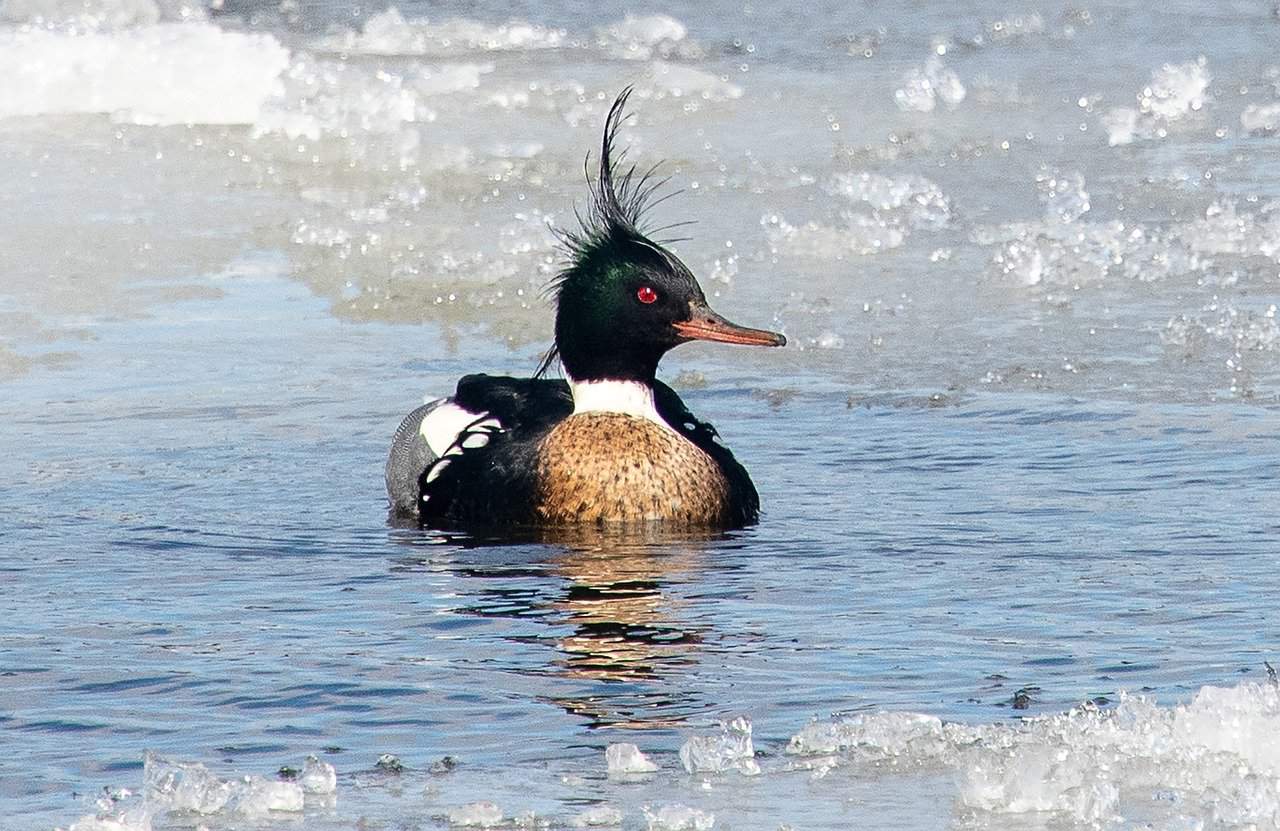
The red-breasted merganser is an unusual duck that has elongated features and a thin bill. The females are grayish brown in color, but their overall appearance is not similar to that of the females of other species. Males have a green, slightly iridescent head with a spiked crest and red eyes, a mottled cinnamon breast, and patches of white, gray, and dark brown on the body.
Although not common in Arkansas, these ducks can be spotted during migration when they rest on lakes and other bodies of water. They are diving sea ducks, which makes it uncommon to see them anywhere but the coasts during non-migratory times. They are intelligent hunters that have been seen working together to herd small schools of fish into shallower water to make them easier to catch. These ducks are rarely hunted due to the unpleasant taste of their meat.
 Conclusion
Conclusion
There are lots of interesting ducks you may encounter in the state of Arkansas at any time of year. Other ducks you may encounter tend to be pets that have escaped or were dumped. Pekin ducks are the most common duck kept as a pet due to their personable nature and bright white plumage. You may also encounter muscovy ducks, which are unusual ducks with red fleshy growths on the face.
If you spot ducks that seem out of place, it’s a good idea to contact the Arkansas Game and Fish Commission to let them know. They will be able to determine if you are dealing with a duck that belongs or not, and it allows them to track populations of rare and unusual ducks.
Featured Image Credit: VancouverLami, Pixabay
